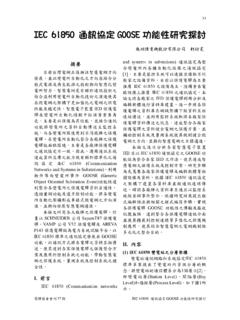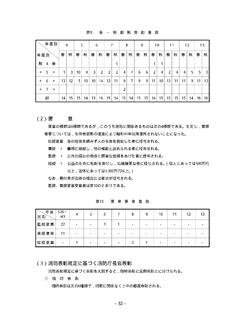Transcription of Overview of IEC 61850 and Benefits
1 1 Abstract-- Legacy substation automation protocols and architectures typically provided basic functionality for power system automation and were designed to accommodate the technical limitations of the networking technology available for implementation. There has recently been a vast improvement in networking technology that has changed dramatically what is now feasible for power system automation in the substation. Technologies such as switched Ethernet, TCP/IP, high-speed wide area networks, and high-performance low-cost computers are providing capabilities that could barely be imagined when most legacy substation automation protocols were designed.
2 IEC61850 is an important new international standard for substation automation that will have a very significant impact on how electric power systems are designed and built for many years to come. IEC61850 is a part of the International Electrotechnical Commission s (IEC) Technical Committee 57 (TC57) architecture for electric power systems. The model-driven approach of the TC57 standards, including IEC61850, is an innovative approach that requires a new way of thinking about substation automation that will result in very significant improvements in both costs and performance of electric power systems.
3 This half-day IEC61850 Tutorial takes a practical approach to helping utility engineers understand how IEC61850 can be used to benefit their organization. The tutorial begins by explaining why these standards are important, how they differ from legacy technology, and how these differences will benefit users. The student is then guided through the IEC61850 standard itself to illustrate how IEC68150 delivers these Benefits via standardized device, object, and service models. Definitions and overviews of the most important concepts will be presented with detailed examples that relate to actual power systems.
4 Index Terms IEC 61850 , standards, Benefits , communications, networking, substation automation, protection relay. I. COMMUNICATION SYSTEM NEEDS ommunication has always played a critical role in the real-time operation of the power system. In the beginning, the telephone was used to communicate line loadings back to the control center as well as to dispatch operators to perform switching operations at substations. Telephone-switching based remote control units were available as early as the 1930 s and were able to provide status and control for a few points.
5 As digital communications became a viable option in the 1960 s, data acquisition systems (DAS) were installed to automatically Ralph Mackiewicz is with SISCO, Inc. of Sterling Heights, MI 48314 USA (e-mail: collect measurement data from the substations. Since bandwidth was limited, DAS communication protocols were optimized to operate over low-bandwidth communication channels. The cost of this optimization was the time it took to configure, map, and document the location of the various data bits received by the protocol.)
6 As we move into the digital age, literally thousands of analog and digital data points are available in a single Intelligent Electronic Device (IED) and communication bandwidth is no longer a limiting factor. Substation to master communication data paths operating at 64,000 bits per second are becoming commonplace with an obvious migration path to much high rates. With this migration in technology, the cost component of a data acquisition system has now become the configuration and documentation component.
7 Consequently, a key component of a communication system is the ability to describe themselves from both a data and services (communication functions that an IED performs) perspective. Other key requirements include: High-speed IED to IED communication Networkable throughout the utility enterprise High-availability Guaranteed delivery times Standards based Multi-vendor interoperability Support for Voltage and Current samples data Support for File Transfer Auto-configurable / configuration support Support for security Given these requirements, work on a next generation communication architecture began with the development of the Utility Communication Architecture (UCA) in 1988.
8 The result of this work was a profile of recommended protocols for the various layers of the International Standards Organization (ISO) Open System Interconnect (OSI) communication system model. This architecture resulted in the definition of a profile of protocols, data models, and abstract service definitions that became known as UCA. The concepts and fundamental work done in UCA became the foundation for the work done in the IEC Technical Committee Number 57 (TC57) Working Group 10 (WG10) which resulted in the International Standard IEC 61850 Communication Networks and Systems in Substations[1].
9 Overview of IEC 61850 and Benefits R. E. Mackiewicz , Member, IEEE C1-4244-0493-2/06/$ 2006 IEEE. 2II. SCOPE AND OUTLINE OF IEC 61850 The stated scope of IEC 61850 was communications within the substation. The document defines the various aspects of the substation communication network in 10 major sections as shown in Table 1 below. TABLE I STRUCTURE OF THE IEC 61850 STANDARD Part # Title 1 Introduction and Overview 2 Glossary of terms 3 General Requirements 4 System and Project Management 5 Communication Requirements for Functions and Device Models 6 Configuration Description Language for Communication in Electrical Substations Related to IEDs 7 Basic Communication Structure for Substation and Feeder Equipment - Principles and Models - Abstract Communication Service Interface (ACSI) - Common Data Classes (CDC)
10 - Compatible logical node classes and data classes 8 Specific Communication Service Mapping (SCSM) - Mappings to MMS(ISO/IEC 9506 Part 1 and Part 2) and to ISO/IEC 8802-3 9 Specific Communication Service Mapping (SCSM) - Sampled Values over Serial Unidirectional Multidrop Point-to-Point Link - Sampled Values over ISO/IEC 8802-3 10 Conformance Testing Parts 3, 4, and 5 of the standard start by identifying the general and specific functional requirements for communications in a substation (key requirements stated above).






